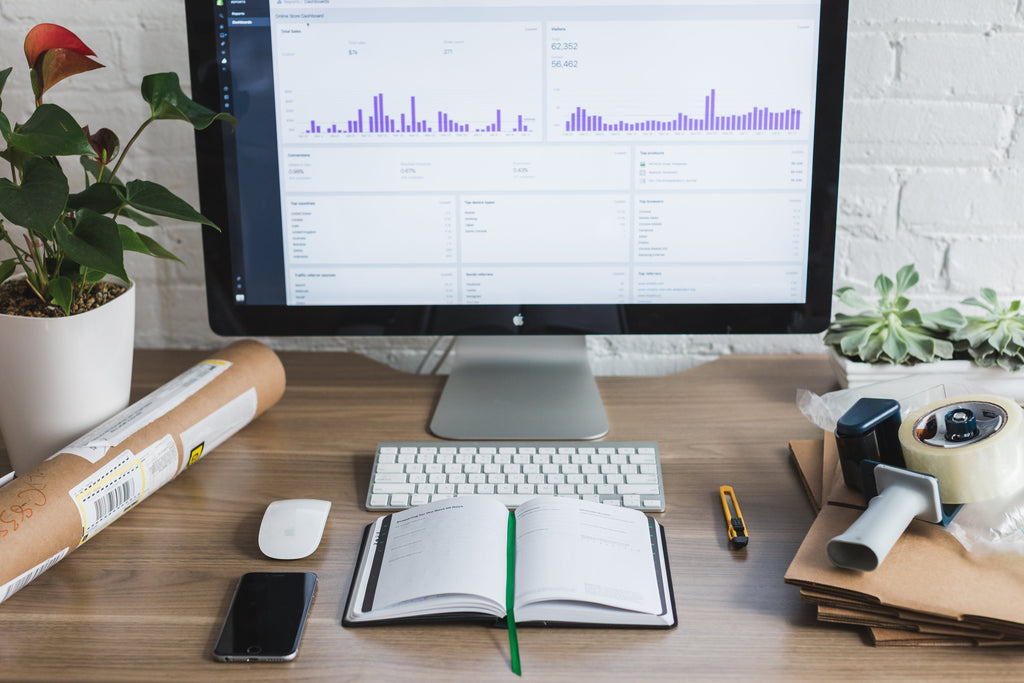If you rely on revenue from a few months to sustain your business all year, forecasting your revenue and expenses isn’t a nice-to-have—it’s a must.
And yes, “forecasting revenue and expenses” sounds exactly like a line from that accounting and finance course you didn’t take (or didn’t like) in school, but it’s not as hard as it sounds. After all, forecasting is just a fancy word for planning.
Even if you work with financial pros, like an accountant or a bookkeeper, you’re still the expert on your product and your industry, because it’s what you focus on most of the time. That insider knowledge is one of the most powerful tools you could ask for when it comes to forecasting, so you’re more than prepared to tackle this.
Plus, a basic forecast will help you make important strategic decisions, like whether you should upgrade your equipment, or when you should place your wholesale orders. Those are the kind of calls you want to be able to make for yourself, and a forecast is one of the best ways to do it.
FREE RESOURCE: We put together a spreadsheet to help you with your forecasting, and you’ll find a link to it later in the post.

Planning ahead is your secret seasonal-business weapon
As a seasonal business, there are some months when it feels like you’re swimming in money—and others where your bank account feels more like a desert with a lone tumbleweed blowing through it.
That’s because in most seasonal businesses, your revenue and your expenses don’t line up. A few months of the year fund your business for the others, and you probably spend your “off” months investing back into your business.
That’s why forecasting your sales and your expenses is even more important for you.
Cover all of your expenses
Business is never easy, let’s get that straight—but it is easier to wing it with your business finances if you earn $5,000 every month, and have $1,500 a month in expenses.
But if you earn $50,000 two months of the year, and your monthly expenses aren’t very stable, forecasting is critical. It’s one more thing that will help you resist those treat-yourself moments in high revenue months, and help cover any shortfalls during the offseason.
It’s one more thing that will help you resist those treat-yourself moments in high revenue months, and help cover any shortfalls during the offseason.
Invest in your business
If you could really use a new laptop or some upgraded equipment, a forecast can help you figure out when you’ll be able to make those big purchases—and if you have the money to do it.
If not, but you really do need the upgrades, a forecast could help you decide whether taking business financing to fund the purchase would be a good move.
Get the capital you need without the complications
With Shopify Capital, you get the money you need to grow your business with just a few clicks. There is no lengthy application process and no paper forms to fill out.
Prepare for the busy season
Stocking up ahead of the busy season is critical, which is why we recommend doing things like stocking up on shipping supplies ahead of a busy sales season like Black Friday Cyber Monday. The importance of preparing for busy times is magnified when the busy season is your only season, so you’ll need to invest in inventory, supplies, and more before you need them.
The importance of preparing for busy times is magnified when the busy season is your only season.
Your forecast can help you map out and manage the expenses of stocking up before the sales start rolling in.
Make strategic decisions
Maybe this is the year you finally decide to spring for seasonal help, or take additional business financing. Making those decisions is much easier when you have an idea of what your year looks like, what you’re committed to spending already, and how much you think you’re going to sell.
Those are decisions that shouldn’t be entirely outsourced to someone else, which is why working through a forecast is so useful.

Forecasting 101
There are two main elements you’ll need to put together an accurate forecast for your business: a sales forecast, and an expense forecast. Once you have both of those done, you’ll be able to get a high-level view of your business’ money matters for the next year—and make some key decisions based on that information.
Sales forecasting
If anything sounds intimidating, it’s “sales forecasting.”
Before your mind is filled with visions of advanced spreadsheets and mathematical models, don’t worry: for the most part, forecasting is just educated guessing. Your job with a sales forecast is to make a reasonable prediction, not to nail the exact numbers you’ll be selling in a year from now.
So how do you do that? There are a few ways to figure out how much you’re going to sell next year. You can look at:
- Industry statistics. Is there a consistent growth rate in your industry, or have analysts predicted a specific growth rate for the next few years?
- Industry peers. Talk to other business owners. When do they typically see the most sales? How much do they sell in a year, roughly?
- Your past years. If you’ve been in business for a while, how much do your sales grow every year? How much did they grow last year, and how much did you sell last year?
- Signed deals. If you’ve got wholesale contracts already in place for next year, you know you’ll sell that much already, so it goes in the forecast.
If you’re a new business, or if you plan on launching new products this year that have no sales history, use what you know about your business and your customer base to make a best guess. You’re the expert on what you do, after all.
Now it’s time to get into the numbers.
Let’s talk products. Specifically, how many do you have? If you’re rocking fewer than five or ten signature products, you can give them each their own, separate forecast. Once your products hit that double-digit mark, you’ll want to group them into product lines for a more manageable forecast.
Set up each product or product line as a row in your spreadsheet, under “Product Unit Sales.” This is where you’re going to input your forecast of how many units you’ll sell of each product this coming year, and which month you’re going to sell them.

Get your own copy of the forecasting spreadsheet template here. Go to File > Make a Copy to save one to your account and keep your forecasts private. (You’ll need to be logged in to a Google account to save your copy.)

Next, add in the prices you plan to sell those products at each month. Maybe you plan on raising your prices mid-year, or you offer so many sales in November that you know your average sale price is lower. Add in those monthly prices now for each product line.

Scroll down a bit, and boom: you have a sales forecast.

Expense forecasting
Now that you’ve got a good idea of what your sales look like over the next year, it’s time to tackle your expenses.
There are two main types of expenses you’ll want to look at when it comes to your forecast: fixed expenses, and variable expenses.
Fixed expenses
We’ll start with fixed expenses, because to be honest, they’re easier.
A fixed expense is something that you pay every month, which could be anything from rent for office space, to software subscription costs, to the salary you pay yourself out of your business.
Pop open your business bank account and take a look at the past few months of transactions. Anything that comes out of your account every month is a fixed expense.
To add it to your forecast, give it its own line in the “Expenses” tab of your spreadsheet, and fill in your monthly cost.

Variable Expenses
For a seasonal business, your variable expenses might not be 100% correlated with your sales—even when it comes to cost of goods sold.
Most forecasts will assume that your cost of goods sold (the money that you spend to create your products) happens in the same month as your sales, but that's not always the case for seasonal businesses. Most of the time, if you didn’t stock up before your busy season, you’d be in for a rough time, and probably lose some sales.
That’s why it’s so important to plan ahead. If most of your expenses happen before your sales, you’ll need to have a plan for how you’re going to cover those expenses when they hit.
FURTHER READING: Forecasting is great for predicting how your revenue and expenses line up annually, but if you want a bit more detail, find out how to plan your business’ cash flow on a more tactical, week-by-week level.
You’ve got your estimates of how much you’ll sell for each product or product line, so let’s work from there. How much does each product cost you to produce? Head to the “Cost of Products” tab in the spreadsheet to enter the unit cost of each product.

This tab of the spreadsheet will calculate the total cost of your products over the year, which you can find at the bottom right-hand side of the sheet.

Take those numbers, and your knowledge of the ordering process, and allocate those costs in the months you plan to spend the money. Maybe the total cost of ordering a product is broken up into a few different parts, or you can order smaller production runs—only you know your business well enough to map out those costs.
Once you do know when you’re going to spend that money, add it in as a variable expense in the “Expense Forecasting” tab of your spreadsheet.

Lastly, add in any other variable expenses you have planned for next year. Are you attending an industry conference, or do you hire seasonal help? Make sure you estimate costs for anything that isn’t a monthly expense, and give them their own rows.
Want to grab your copy of the spreadsheet? You can find the forecasting spreadsheet template here. Go to File > Make a Copy to save one to your account and keep your forecasts private. (You’ll need to be logged in to a Google account to save your copy.)

Adjust as you go
Your forecast isn’t set in stone, and one of the most useful things you can do is adjust the numbers as you get more information.
Right off the bat, you might realize that some of your variable expenses aren’t hitting at the right time, and you might want to move them around.
Later on, as sales and orders start to come in, you might realize you need to adjust your sales forecast, and your corresponding costs to fulfill those orders.
You might even realize that yes, you do need to secure some business financing, and you’ll have a good idea of how you’re going to use the money, since you’ve already got a plan.
And that’s all OK.
In fact, it’s great, and it’s the best part of having an annual forecast in place for your seasonal business. Being able to adjust your plan, instead of hoping for the best when things change, will help you feel on top of your business finances all year round.
